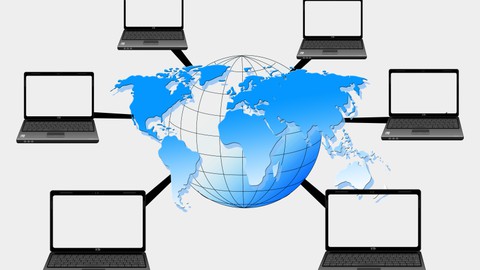
Basics of Computer Networking and Fault finding
Basics of Computer Networking and Fault finding, available at Free, has an average rating of 3.9, with 15 lectures, based on 84 reviews, and has 3552 subscribers.
You will learn about Students will able to design simple Computer networks and Troubleshoot Faults in Computer Networks Introduction to analysis and design of computer and communication networks through understanding the network layered architecture and the protocol stack and by conducting hands-on programming and practical lab activities. This course is ideal for individuals who are Engineering students with some background of electronics It is particularly useful for Engineering students with some background of electronics.
Enroll now: Basics of Computer Networking and Fault finding
Summary
Title: Basics of Computer Networking and Fault finding
Price: Free
Average Rating: 3.9
Number of Lectures: 15
Number of Published Lectures: 15
Number of Curriculum Items: 15
Number of Published Curriculum Objects: 15
Original Price: Free
Quality Status: approved
Status: Live
What You Will Learn
- Students will able to design simple Computer networks and Troubleshoot Faults in Computer Networks
- Introduction to analysis and design of computer and communication networks through understanding the network layered architecture and the protocol stack and by conducting hands-on programming and practical lab activities.
Who Should Attend
- Engineering students with some background of electronics
Target Audiences
- Engineering students with some background of electronics
-
Introduction to Computer Networks
• Understanding network architectures, protocol layers, and their service models.
• Principles of network applications: o Application layer protocols such as HTTP, FTP, and SMTP. o Peer-to-Peer File Sharing Protocols and Architectures. o ISPs and Domain name systems. o Socket API and network socket programming.
• Understanding reliable and unreliable transport-layer protocols: o GBN and SR. TCP and UDP. Port numbers. o Multiplexing and demultiplexing. o Flow control and congestion control. Fairness. o Delay, jitter, and loss in packet-switched networks. o Bandwidth, throughput, and quality-of-service. • Understanding network layer services and protocols. o Switching fabric: o Routing and forwarding. o Queues and buffering. o Virtual-circuit and datagram networks. o Internet protocol. IPv4 and IPv6. Tunneling. o LS and DV algorithms. o Routing in the Internet. RIP, OSPF, and BGP. o Broadcast and multicast. o Handling mobility.
• Understanding network layer services and protocols: o Link-layer and its services. o Ethernet, hubs, bridges, and switches. o Link-layer addressing. o Error-detection and error-correction. Parity, check-summing, CRC. o Manchester encoding. ATM and MPLS. o Local area networks and IEEE 802.11 wireless LANs. o Multiple-access protocols. Random access. o Efficiency of pure and slotted ALOHA. CSMA, CSMA/CD, and CSMA/CA.
• Introduction to physical-layer services and systems: o Introduction to physical media. o Coax, fiber, twisted pair, DSL, HFC. o WiMax, cellular, satellite, and telephone networks. o Bit transmission. o Frequency division multiplexing. Time division multiplexig.
Course Curriculum
Chapter 1: Introduction
Lecture 1: Introduction to Computer Networks
Lecture 2: Layered Task
Lecture 3: OSI Model
Lecture 4: Physical Layer
Lecture 5: Data Link Layer
Lecture 6: Network Layer
Lecture 7: Transport Layer
Lecture 8: Session and Presentation Layer
Lecture 9: Application Layer
Chapter 2: Transmission Media
Lecture 1: Introduction to Transmission Media
Lecture 2: Twisted Pair Cable
Lecture 3: Coaxial Cable
Lecture 4: Optical Fiber Cables
Lecture 5: Electromagnetic Spectrum For Wireless
Lecture 6: Wireless Transmission Wave
Instructors
-
Ramesh Khinde
Electronics Professor
Rating Distribution
- 1 stars: 4 votes
- 2 stars: 8 votes
- 3 stars: 18 votes
- 4 stars: 21 votes
- 5 stars: 33 votes
Frequently Asked Questions
How long do I have access to the course materials?
You can view and review the lecture materials indefinitely, like an on-demand channel.
Can I take my courses with me wherever I go?
Definitely! If you have an internet connection, courses on Udemy are available on any device at any time. If you don’t have an internet connection, some instructors also let their students download course lectures. That’s up to the instructor though, so make sure you get on their good side!
You may also like
- Best Cybersecurity Fundamentals Courses to Learn in March 2025
- Best Smart Home Technology Courses to Learn in March 2025
- Best Holistic Health Courses to Learn in March 2025
- Best Nutrition And Diet Planning Courses to Learn in March 2025
- Best Yoga Instruction Courses to Learn in March 2025
- Best Stress Management Courses to Learn in March 2025
- Best Mindfulness Meditation Courses to Learn in March 2025
- Best Life Coaching Courses to Learn in March 2025
- Best Career Development Courses to Learn in March 2025
- Best Relationship Building Courses to Learn in March 2025
- Best Parenting Skills Courses to Learn in March 2025
- Best Home Improvement Courses to Learn in March 2025
- Best Gardening Courses to Learn in March 2025
- Best Sewing And Knitting Courses to Learn in March 2025
- Best Interior Design Courses to Learn in March 2025
- Best Writing Courses Courses to Learn in March 2025
- Best Storytelling Courses to Learn in March 2025
- Best Creativity Workshops Courses to Learn in March 2025
- Best Resilience Training Courses to Learn in March 2025
- Best Emotional Intelligence Courses to Learn in March 2025






















